News


You hear about data breaches almost every week. Big companies, small businesses, even government agencies have all been hacked. Your personal information is likely floating around in places you don’t even know about. That’s a reality we all live with. The question is: what are you doing to protect yourself? Ignoring it isn’t an option. If your identity is compromised, the impact can be expensive, time-consuming, and stressful, especially when your financial accounts are involved.
At Worth Advisors, we know that wealth protection isn’t just about investments. It’s also about making sure your accounts, personal data, and financial records are secure. Building wealth is only part of the equation. Keeping it safe is just as important.
How Identity Theft Happens
Identity theft happens when someone gains access to your personal information like your Social Security number, bank details, or online account credentials, and uses it to commit fraud. This can happen in several ways:
- Phishing Scams: Emails, texts, or calls that trick you into giving up sensitive information.
- Data Breaches: Hackers infiltrate company databases and steal personal data.
- Public Wi-Fi: Using unsecured Wi-Fi networks can expose your data to hackers.
- Lost or Stolen Devices: Phones, laptops, and tablets that aren’t secured can be a goldmine for thieves.
- Malware and Spyware: Downloading files from unknown sources or clicking suspicious links can install malicious software on your devices, giving hackers access to your information.
Once someone has your data, they can open credit accounts, access bank accounts, transfer funds, and even attempt to impersonate you to financial institutions. The last thing any investor or family wants is to see their hard-earned wealth drained due to preventable security gaps.
Steps to Protect Your Wealth and Personal Information
Protecting your information doesn’t require tech skills, just some awareness and good habits.
- Use Strong, Unique Passwords: Don’t use the same password for multiple accounts. Use a password manager to create and securely store complex passwords.
- Enable Two-Factor Authentication: This adds a second layer of protection, like a text code or authentication app, to your logins. This is especially important for financial accounts.
- Monitor Your Credit: Regularly check your credit reports. You can access a free report from each of the three major credit bureaus once a year at AnnualCreditReport.com.
- Monitor Financial Accounts: Set up account alerts on your bank, investment, and credit card accounts to catch suspicious activity early.
- Be Skeptical of Unsolicited Contacts: If someone asks for personal information by phone, email, or text, even if they claim to be from your bank, verify their identity first.
- Secure Your Devices: Use screen locks, keep software up to date, and install antivirus protection on your devices.
- Limit Public Wi-Fi Use: Avoid accessing sensitive accounts or making transactions on public Wi-Fi. If you must use it, connect through a virtual private network (VPN).
- Shred Sensitive Documents: Physical security matters too. Shred documents that contain personal information before disposing of them.
- Use Secure Websites: When shopping or banking online, ensure the website uses HTTPS. This encrypts your data and helps protect your information from interception.
- Be Careful on Social Media: Avoid sharing personal details like your birthday, address, or answers to common security questions. This information can help scammers piece together enough data to impersonate you.
Protect Your Wealth Beyond the Market
No system is foolproof, but the more barriers you put in place, the harder it becomes for thieves to get what they want. At Worth Advisors, protecting your wealth goes beyond market strategy. It includes helping you safeguard your financial information and identity. If you’re serious about locking down your financial life, let’s talk about a strategy that protects not just your investments, but everything connected to them.
Disclaimer: The information contained in this article is intended for discussion purposes only. The information included herein is highly confidential, intended for review by the recipient only, and should not be disseminated or made available for public use or to any other source. It is not an offer or a solicitation for the sale of a security, nor shall there be any sale of a security in any jurisdiction where such offer, solicitation, or sale would be unlawful. An investment with Worth Advisors (whether through a commingled fund or on a separate account basis) involves a degree of risk and may only be made pursuant to the respective offering documents and organizational materials governing such investment. Past performance of the clients of Worth Advisors, or any of its employees or principals, may not be indicative of future results, and there is no guarantee that targeted performance will be achieved. The entirety of investors’ capital is at risk.

Getting older comes with its perks—more time, more flexibility, and in some cases, tax breaks. If you’re in or approaching retirement, it’s worth understanding the tax benefits available to seniors. These opportunities can help you keep more of your money and stretch your retirement income further. The catch? Many people miss out simply because they don’t know what to look for.
Common Tax Breaks Available to Seniors
Once you turn 65, the IRS provides a higher standard deduction. With the recently passed One Big Beautiful Bill Act, seniors can claim an additional deduction of $6,000.
Some seniors may also qualify for the Credit for the Elderly or Disabled, which can reduce your tax bill if your income is below certain thresholds. While not everyone qualifies, it’s worth checking if you meet the income and disability criteria.
Additionally, many states offer property tax exemptions or reductions for seniors. The rules vary by state and sometimes even by county, but these programs can significantly reduce your annual property tax bill.
Social Security benefits might not be taxed at all, depending on your combined income. If Social Security is your main or only source of income, your benefits could remain tax-free. However, if you have other income sources, up to 85% of your Social Security benefits may be subject to federal taxes.
Some seniors may also benefit from the Retirement Savings Contributions Credit (Saver’s Credit). Although less common among retirees, if you’re still earning income and contributing to retirement accounts like an IRA or 401(k), you might qualify for a tax credit worth up to 50% of your contributions, depending on your income.
Strategies to Maximize Tax Savings in Retirement
Tax relief for seniors isn’t just about deductions and credits, it’s also about smart planning. Here are a few strategies to consider:
- Withdraw Strategically: Be mindful of when and how you withdraw funds from retirement accounts, such as traditional IRAs or 401(k)s. These withdrawals count as taxable income, and taking out too much in one year can bump you into a higher tax bracket.
- Roth Conversions: Converting part of your traditional IRA to a Roth IRA can help reduce future taxable income since Roth withdrawals are tax-free in retirement. Spreading conversions over several years may help you manage taxes more effectively.
- Qualified Charitable Distributions (QCDs): If you’re 70½ or older, you can donate directly from your IRA to a charity. The amount donated counts toward your required minimum distribution (RMD) but doesn’t count as taxable income.
- Health Savings Accounts (HSAs): If you’re still working and eligible, contributing to an HSA provides tax-free savings for medical expenses, which can be significant in retirement. Even after you turn 65, you can continue using your HSA for medical costs tax-free.
- Timing Social Security Benefits: Waiting to claim Social Security can not only increase your monthly benefit but also help you manage your taxable income in the early years of retirement. This can help avoid triggering higher taxes on Social Security or being subject to Medicare surcharges.
- Track Medical Expenses: Seniors often have higher healthcare costs, and if these expenses exceed 7.5% of your adjusted gross income, they may be deductible if you itemize your taxes. Keeping good records of medical costs can lead to additional deductions.
- Take Advantage of State-Level Benefits: In addition to federal tax relief, many states offer further benefits for retirees, such as exempting certain retirement income from taxation or providing additional property tax relief. Review your state’s tax codes or consult a financial advisor to ensure you’re not missing out.
Make the Most of Every Opportunity
Tax relief for seniors isn’t automatic. It takes some attention and planning to ensure you’re maximizing the benefits available to you. The right approach can help you keep more of what you’ve earned, support your lifestyle in retirement, and preserve wealth for future generations.
At Worth Advisors, we help you uncover the opportunities that fit your specific situation and build a strategy that keeps your retirement on track. If you’re ready to make sure your tax strategy is working as hard as you do, let’s connect.
It’s no secret that the exceptional market returns over the last two years have been driven primarily by a handful of the largest technology companies in the U.S. markets. Recent market volatility, which has been triggered by tariffs and breakthroughs in Artificial Intelligence (AI) by a Chinese technology company, is a reminder that even the strongest of bull markets can suffer corrections, especially when market-leading stocks are priced to perfection.
It’s often been said that “uncertainty breeds market volatility”. Since making new all-time highs earlier this year, the U.S. equity markets are providing a real-time example of this belief. While the current state of the markets is both elevated and unwelcome, volatility is a reality that equity investors must endure.
So, how did we get here? Short answer – Government spending has grown faster than the Gross Domestic Product (GDP). As of March, the current U.S. national debt is approximately $36.2 trillion. The current U.S. annual budget deficit is approximately $1.8 trillion. Government spending is now in the 20% to 25% range of GDP and the Federal Reserve balance sheet, along with the M2 money supply, has ballooned accordingly.
The resulting inflation from all of the Government money in the system has had a positive effect on those who own assets (stocks, real estate, etc.), as asset prices have moved higher. However, inflation has a negative effect on consumers (basically a tax) as well as the overall economy. The days of ‘easy’ money are over, as are the days of the U.S. Government printing and spending at the onset of every new ‘crisis.’
Enter a new administration with an ambitious new agenda. Reminiscent of 1981 when Ronald Reagan (after defeating Jimmy Carter in the 1980 election) inherited an economy with double-digit inflation and interest rates hovering near 20%. Like Reagan’s economic plan, the Trump administration will attempt to encourage economic growth by enacting pro-growth policies, reducing government spending, and cutting tax rates. One difference is that when Reagan took office, facing a severe recession, the Price Earnings Multiple (PE Ratio) on the S&P 500 index was 8.5. Conversely, the Trump administration takes over an S&P 500 index, fueled by government spending and inflation, at all-time highs and a PE ratio of 27.
The uncertainty surrounding the Trump administration’s tariff policies will invariably have some effect on inflation, supply chains, employment, economic growth, and corporate profits. President Trump’s announcement of the tariffs sent the markets reeling back into correction mode, sending the major indexes down approximately 4% – 6%. The sweeping tariffs-which include an across-the-board 10% tariff on imports and will top 50% for some countries, including China- far surpassed what most analysts anticipated. Volatility has spiked, and recession fears have been elevated. Some of these tariffs may be well intended, such as a necessity to combat other countries that have abused their trading status with the U.S. While any reconfiguration of the world economic order will come at a cost, the establishment of a new landscape will allow corporations to regain confidence and begin investing within the new framework. Any such transitions usually create new investor opportunities as companies adjust their operations. As a general rule, though policy and economic uncertainty are difficult for both CEOs and investors alike, we are usually better served to focus on actual data rather than get caught up in the multitude of theories as to what might happen in the wake of a change in policies.
As we digest the never-ending stream of breaking news, we must always try to discern between the short-term headlines and the longer-term structural trends. Market corrections occur regularly. Over the past 40 years, the S&P 500 index has seen a drop of at least 10% in 18 of those years. Since 2000, after the S&P 500 has experienced a correction of at least 10%, the average total return over the following 3-year period was 35%. And looking back to 1928, the S&P 500 index has been positive 73% of the time; an average of 3 years out of every 4.
Many investors tend to overreact to volatility, decreasing their exposure to risk assets in the markets. Over the long term, this can be a mistake. This is especially true today as the U.S. and the rest of the world are on the verge of an AI-driven revolution, a theme that has just gotten considerably cheaper to access. Technology is changing the world faster than most anticipated. Productivity and automation are soon to follow. These expectations could arguably be recognized and reinforced by economies across the globe.
Uncertainty about U.S. policy will remain high. We assume a slowdown in U.S. economic growth, and a negative impact on inflation. We can also assume a significant effect on countries outside the U.S. And let’s not overlook the existing geopolitical risks as the conflict in the Middle East continues, and a resolution to the Russia-Ukraine war remains uncertain.
If anything, our economy is resilient, though we now see the economy slowing to 1% – 1.5% in 2025 as higher tariffs weigh on disposable income, consumer spending, and business investment. We expect core PCE inflation will remain sticky at approximately 3.5% – 3.75%, still above the Federal Reserve’s 2% objective. The market is currently pricing in 2 – 3 interest rate cuts by the Federal Reserve this year. So, we do see a softening economic environment, but not a recession at this point in time. We will, as will the entire industry, continue to monitor policy developments and their potential impact on economies and corporations across the globe.
Let’s be honest—money is one of the biggest factors shaping our daily lives. Whether you’re thinking about retirement, buying a home, or just making sure you can take that vacation next summer, how you handle your finances determines what’s possible. Yet so many people move through life without a clear financial direction. They make money, spend money, and hope it all works out. But hope isn’t a strategy. If you want financial security and the freedom to make choices that matter, you need two things: a goal and a plan to get there.
The Power of Financial Goals
Financial goals give you purpose. They help you take control of your money rather than letting your money control you. Here’s why they matter:
- Direction: Without goals, your money lacks purpose. Clear objectives help you stay on track.
- Motivation: Goals keep you focused, even when temptations arise to spend on things that don’t align with your priorities.
- Measurability: When your goals are specific, you can track your progress and celebrate milestones.
- Decision-Making: When faced with financial choices, having goals in place makes it easier to determine the right path.
Good financial goals follow the SMART framework—Specific, Measurable, Achievable, Relevant, and Time-bound. Instead of saying, “I want to save money,” set a SMART goal: “I will save $5,000 for an emergency fund within 12 months.” This gives you a clear target and a timeframe to make it happen.
The Role of Financial Planning
Once you have goals, you need a plan to reach them. Without a plan, even the best goals are just wishful thinking. Here’s what a strong financial plan does for you:
- Roadmap: A plan outlines the steps you need to take to reach your financial goals.
- Resource Allocation: It helps you determine how to allocate your income effectively.
- Risk Management: A well-structured plan identifies potential risks and prepares you for unexpected challenges.
- Flexibility: Life happens—your plan should be able to adapt along the way.
A solid financial plan includes budgeting, saving, investing, debt management, and insurance. It’s not something you set and forget. As your life changes, your plan should evolve too.
Goal-Setting and Planning in Action
Let’s say your goal is to buy a house in five years. Here’s how setting a SMART goal and creating a financial plan work together:
- Set the SMART Goal: “Save $50,000 for a house down payment within 5 years.”
- Break It Down: That means saving $10,000 annually or about $833 monthly.
- Create a Plan:
- Review your budget and cut unnecessary expenses.
- Set up automatic transfers to a high-yield savings account.
- Explore ways to increase income, like a side hustle or negotiating a raise.
- Invest a portion of the savings for potential higher returns.
- Monitor and Adjust: Regularly check progress and make adjustments as needed.
This structured approach ensures that a daunting goal becomes manageable and achievable.
Common Pitfalls and How to Avoid Them
Even with the best intentions, common mistakes can derail financial success. Here’s what to watch out for:
- Setting Unrealistic Goals: Be ambitious, but make sure your goals are attainable to avoid frustration.
- Not Sticking to Your Budget or Goals: As Sy Pugh puts it, “What is the purpose of setting a goal if you do not have plans to attain it in the first place?”
- Neglecting to Review and Adjust: Financial plans should change as your life does.
- Focusing Only on Long-Term Goals: Balancing short-term and long-term financial priorities keeps you healthy.
- Being Too Prideful to Seek Help: There’s no shame in getting guidance when you need it.
Ready to Take Control of Your Financial Future?
Financial goals and a solid plan can mean the difference between drifting through life and achieving real financial security. If you’re ready to take charge of your finances, Worth Advisors is here to help. Let’s build a strategy that aligns with your goals so you can confidently move forward.
Debt doesn’t just weigh on your wallet; it can take up space in your mind. Late-night worries, second-guessing purchases, and feeling stuck are all too everyday. The good news? Paying off debt isn’t about having a secret formula—it’s about action, consistency, and smart choices. Debt doesn’t define financial success; how you handle it does. Building a plan tailored to your situation turns financial stress into financial freedom. No matter the amount owed, decisive action and commitment create a path forward.
Practical Strategies Anyone Can Use
Prioritize high-interest debt. Credit cards and payday loans often have steep interest rates that quickly grow balances. Tackling these first reduces the amount you’ll pay over time. Start with the highest interest rate account and work your way down—this approach saves money and accelerates the payoff timeline. It’s like plugging the most significant leaks in a sinking ship; addressing them first keeps everything afloat. Consistently focusing on these costly debts shortens repayment periods and frees up cash for other goals.
For those who crave quick wins, the snowball method works wonders. It involves paying off the smallest debts first while making minimum payments on more significant balances. Each small victory builds confidence and momentum. Motivation grows as the number of debts shrinks. This psychological boost makes a difference when repayment feels overwhelming. The snowball method transforms what feels like a marathon into a series of achievable sprints, keeping morale high throughout the process.
Make more than the minimum payment. Minimum payments prolong debt and increase interest costs. By paying extra—even a small amount—you chip away at principal balances faster, slashing the total amount paid in the long run. Small sacrifices today lead to significant savings tomorrow. Think of it as speeding up the clock on financial freedom. Cutting down the repayment timeline by months or even years brings debt relief into the near future.
Creating a budget sets the foundation for any debt repayment plan. Budgets don’t restrict freedom; they provide clarity. Identify how much you can allocate toward monthly debt by tracking income and expenses.
Pair this with an emergency fund so unexpected expenses don’t force you to rely on credit cards, undoing your hard work. A well-constructed budget ensures debt repayment stays on track while leaving room for essential expenses. Incorporating an emergency fund acts as a financial buffer, preventing unexpected costs from derailing progress and offering peace of mind during repayment.
Approaches For Long-Term Debt Management
Debt consolidation can streamline your payments and reduce interest rates. Consolidating debt into a single loan with a lower interest rate simplifies repayment and reduces overall costs. This approach reduces the mental load of juggling multiple due dates and payment amounts.
However, it only works when paired with disciplined financial habits—consolidation without behavior change leads to repeated debt cycles. Borrowers should also compare consolidation loan terms to ensure they save money in the long run. With the right strategy, consolidation can be the bridge from debt management to wealth-building opportunities.
Equally important is resisting the temptation to take on new debt during repayment. It’s easy to undo progress by slipping back into old patterns. If spending habits aren’t adjusted, new debt can pile on top of existing balances, making repayment harder. Commitment to avoiding additional debt is critical for lasting results. This requires building better financial habits, such as
delayed gratification and mindful spending. Breaking the debt cycle means eliminating current balances and adopting sustainable financial behaviors for the future.
Sometimes, seeking professional help is the best move. Financial advisors and certified credit counselors offer guidance, accountability, and strategies tailored to specific situations. Experienced advice can distinguish between years of debt stress and a clear path forward. Experts can help analyze your debt situation, recommend suitable repayment plans, and negotiate with creditors if necessary. Partnering with professionals ensures that repayment strategies align with long-term financial goals, making the process more efficient and less daunting.
Building a Stronger Financial Future
Paying off debt isn’t just about numbers—it’s about regaining freedom. Practical strategies, such as prioritizing high-interest balances, embracing the snowball method, budgeting wisely, and considering consolidation, make the path to a debt-free life more apparent. Staying committed means avoiding new debt and seeking help when needed.
Sticking to a structured plan leads to more than just debt elimination—it lays the groundwork for wealth accumulation. A debt-free lifestyle allows for investments in savings, retirement accounts, and other financial growth opportunities. Every step toward eliminating debt builds the confidence and discipline needed to tackle larger economic goals.
Everyone deserves access to actionable financial advice. If you’re ready to move from debt management to wealth building, set up an appointment with Worth Advisors. Your future self will thank you.
Whether you earn a modest income or manage multiple revenue streams, setting financial goals and crafting a thoughtful plan transforms how you approach your finances. It’s not about wealth but intentionality and creating a framework for success.
The Power of Financial Goals
Financial goals serve as a compass, giving your resources direction and purpose. Without them, you risk aimlessly spending without a clear sense of progress. Goals provide focus, helping you prioritize what matters most in your financial life.
Consider the motivational boost that comes from having a target. Saving for a rainy day is one thing, but saving $5,000 in 12 months for an emergency fund is an actionable goal with measurable steps. The difference lies in clarity—specific goals allow you to track progress, celebrate milestones, and adjust course when necessary.
Financial goals also guide decision-making. Deciding whether an impulse purchase aligns with your priorities is easier when you know what you’re working toward. Think of financial goals as a filter for spending habits, ensuring every dollar has a purpose.
SMART goals—Specific, Measurable, Achievable, Relevant, and Time-bound—are the gold standard. For example, instead of saying, “I want to save for a house,” set a goal like, “I will save $50,000 for a down payment within five years.” Breaking goals into actionable steps makes them achievable and keeps you motivated.
The Role of Financial Planning
If financial goals are the destination, financial planning is the roadmap. A well-crafted plan connects where you are now to where you want to be, offering a step-by-step guide for getting there. Planning helps you allocate resources efficiently, ensuring that your income supports your objectives without unnecessary waste. It also helps manage risk. From insurance to emergency funds, a financial plan identifies potential threats and ensures you have contingencies in place.
For example, budgeting is a key aspect of a financial plan. It allows you to meet your everyday expenses without sacrificing savings. A good plan also accounts for flexibility, allowing you to adjust to unexpected changes like job shifts or market fluctuations.
Imagine saving for retirement while also trying to pay off student loans. A thoughtful plan balances these competing priorities, ensuring progress on both fronts. Financial planning isn’t static; it evolves alongside your life circumstances, making it a dynamic tool for long-term stability.
Common Pitfalls and How to Avoid Them
Potential missteps can derail progress even with clear goals and a solid plan. Avoiding these pitfalls requires self-awareness and a willingness to adapt. One common mistake is setting unrealistic goals. Ambition is commendable, but it needs to be tempered with practicality. Saving half your income might sound good on paper, but you will likely abandon the effort if it leaves you stretched too thin.
Another issue is neglecting to review and adjust your plans. Life is rarely static, and your financial strategy should reflect changes like marriage, children, or career shifts. Periodic reviews ensure your plan remains relevant and practical.
Focusing solely on long-term goals is another trap. While retirement savings are crucial, neglecting short-term needs like building an emergency fund can leave you vulnerable to unexpected expenses. Balancing short-term and long-term priorities prepares you for immediate and future needs. Finally, don’t let pride prevent you from seeking help. Financial planning can be complex, and there’s no shame in consulting a professional.
Financial Planning Is For You; It’s For Everyone
Financial goals and planning aren’t just for those with significant assets—they’re for anyone who wants to control their financial future. Setting clear objectives and crafting a plan creates a framework for making informed decisions and reaching milestones. Avoiding common pitfalls ensures that your efforts lead to lasting success.
Worth Advisors can help guide you toward a financial future that aligns with your goals and values, whether you’re just starting or refining an existing strategy. Let’s create a plan that works for you because everyone deserves the confidence that comes with financial clarity. Set up a meeting with us so we can support you and your financial goals.
Compound interest is a key factor in building wealth over time. Unlike the myth surrounding “timing the market,” compounding interest will work for everyone. It becomes an even more powerful financial tool when combined with tax-advantaged accounts. These accounts allow your money to grow without annual tax interruptions, helping you to maximize the benefits of compounding. Understanding how these two elements work together can help you make better decisions for your financial future.
The Magic of Compounding Interest
Compound interest is earning interest on both your initial investment and accumulated interest. Over time, this creates exponential growth. The longer your money remains invested, the more significant the compounding effect becomes.
For example, if you invest $100 in an account earning 5% annual interest, you’ll have $105 after the first year. In the second year, the 5% applies to $105 instead of just $100.
This “interest on interest” creates a snowball effect. A portion of your growth is often lost to taxes every year in taxable accounts. This reduces the compounding effect because the taxed amount is no longer working for you. In contrast, tax-advantaged accounts like IRAs or 401(k)s let your investments grow tax-deferred or tax-free, allowing the total value to compound. This uninterrupted growth can lead to significantly higher returns over the long term.
How to Maximize Your Return Through Tax-Advantaged Accounts
Tax-advantaged accounts provide a framework for maximizing the impact of compound interest. These accounts generally fall into two categories: tax-deferred and tax-exempt.
Tax-Deferred Accounts
Traditional IRAs, 401(k)s, and 403(b)s are tax-deferred accounts. You won’t pay taxes on your earnings until you withdraw the funds. During your working years, you can contribute pre-tax dollars. This effectively allows you to reduce your taxable income for the year. This lowers your immediate tax liability and leaves more money in the account to grow.
The key advantage of tax-deferred accounts is that taxes are typically paid during retirement, when your income may be lower, potentially putting you in a lower tax bracket. This means you’re not only deferring taxes but also paying less in the future.
Tax-Exempt Accounts
Tax-exempt accounts, such as Roth IRAs, are funded with money after you have already been taxed. People are drawn to them because of the growth in the account, and all qualified withdrawals are tax-free. Remember, you may join a higher tax bracket when you get older. These accounts allow you to pay taxes when you deposit, even if you may be a lower one.
Your Roth IRA will grow tax-free for decades. Even if your investments generate substantial returns, you won’t owe taxes on those earnings when you withdraw the funds. This allows you to keep more of your compounded growth.
Maximizing Contributions and Starting Early
The benefits of compound interest grow exponentially with time, making it crucial to start as early as possible. You can take full advantage of compounding and tax benefits by consistently contributing the maximum allowable amount to tax-advantaged accounts each year.
For example, in 2024, the IRS allows up to $23,000 in contributions to a 401(k) for individuals under 50, with an additional $7,500 for those aged 50 and older. Similarly, IRAs have a $7,000 limit for individuals over 50. Maximizing these contributions yearly creates a larger principal base for compounding, translating into more significant growth over time.
Take Action to Secure Your Financial Future
Combining compound interest and tax-advantaged accounts is a proven way to grow wealth efficiently. By allowing your investments to grow uninterrupted by taxes, these accounts amplify the effects of compounding and provide a clear path to long-term financial success.
If you’re ready to learn how tax-advantaged accounts work, schedule a consultation with Worth Advisors today. We can help you create a strategy that maximizes your savings and puts you on track to achieve your goals.
Disclaimer: Always consult a financial, tax, or legal professional familiar with your unique circumstances before making any financial decisions. This material is intended for educational purposes only. Nothing in this material constitutes a solicitation to sell or purchase any securities. Any rates of return are historical or hypothetical in nature and are not a guarantee of future returns, which may be lower or higher. Investments involve risk. Investment values will fluctuate with market conditions and security positions, which, when sold, may be worth less or more than their original cost.







